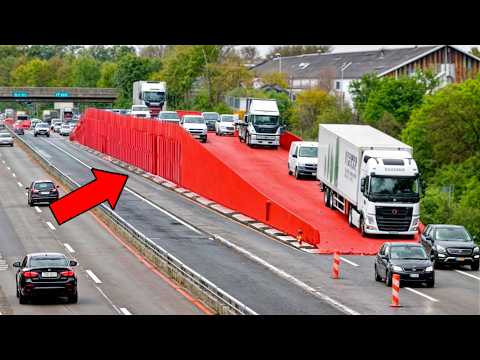UNIQUE German AUTO Technology! They Are Asphalting The Roads Without Stopping Traffic!

the German Autobon nowhere else in the world are you allowed to drive as fast as here about one half of Germany's Autobon network has no speed limit each year more than 2 million accidents occur on the German Autobon partly a result of inexperienced Racers when you think of Cutting Edge infrastructure Germany likely comes to mind from the Precision of their engineering to the efficiency of their construction processes the Germans have consistently set the global standard the top IC today is nothing short of amazing how Germany has perfected the art of road construction allowing them to lay highquality asphalt without halting traffic this remarkable fee is not just a matter of efficiency it's a testament to the country's Innovative Spirit engineering prowess and commitment to progress but how did Germany Reach This level of Mastery in road construction to understand this we must first delve into the historical evolution of road building in the European Empire let's start with the roots of modern road construction a journey that takes us back to the early 18th century when Europe experienced a Revival of ancient Roman Road building techniques this period marked a pivotal moment in the history of Transportation as the methods used by the Romans began to resurface and significantly impact the way roads were constructed across the continent prior to this revival roads were little more than dirt paths treacherous and unreliable able especially during inclement weather when it rained these paths would turn into muddy quagmires making travel not only difficult but often dangerous these primitive roads were far from ideal hindering trade communication and the movement of people the Romans however revolutionized road construction by introducing methods that would lay the groundwork for modern infrastructure they didn't just build roads they engineered them with a meticulous approach that ensured their longevity and usability Roman roads were designed with a layered structure known as Madam construction a term that refers to their method of laying down multiple layers of materials each serving a specific purpose the foundation layer typically made of large Stones provided stability and support above this a layer of smaller stones and gravel was added to create a level surface while the top layer often composed of tightly packed cobblestones offered a durable and smooth riding surface the Romans also understood the importance of drainage incorporating sophisticated systems that prevented water from pooling on the road surface and causing damage these ancient techniques though developed thousands of years ago are still relevant today they provide the foundation upon which modern roadways are built demonstrating the enduring Legacy of Roman engineering the Revival of these techniques in the 18th century was more than just a nod to history it was a recognition of their effectiveness and a a testament to their resilience as time progressed in the Advent of motorized vehicles transformed Transportation the limitations of these older roads became apparent the uneven surfaces of gravel and cobblestones once sufficient for horsedrawn carriages were no match for the speed and weight of cars and trucks and dust clouds kicked up by Vehicles traveling on these surfaces post significant safety hazards reducing visibility and increasing the risk of accidents moreover the roughness of the roads cause discomfort for passengers and wear and tear on vehicles this growing need for safer smoother roads led to the development of new materials namely asphalt and concrete the introduction of these materials marked a significant milestone in road construction asphalt a mixture of aggregate and biteen became the material of choice for many road projects due to its smoothness flexibility and ease of application it could be laid quickly providing a seamless surface that reduced the risk of skidding and improved driving Comfort concrete while less flexible than asphalt offered Superior durability and was often used for roads that would bear heavy traffic loads such as highways and major city streets in Germany a country that has long been at the Forefront of engineering and Innovation road construction evolved dramatically as these new materials came into play the nation's approach to infrastructure development became a model of efficiency and precision modern Road structures in Germany are meticulously planned and constructed encompassing not only the roads themselves but also pedestrian walkways bike lanes and other features that ensure the safety and convenience of all travelers the choice of materials whether asphalt concrete or cobblestones depends on various factors including traffic volume climate conditions and the specific requirements of the project asphalt for instance is favored for large public projects like highways due to its flexibility which allows for smooth Transitions and curves this flexibility also makes it more resistant to the expansion and contraction caused by temperature changes reducing the likelihood of cracks and potholes however the choice of asphalt is not without its challenges heavy traffic combined with high temperatures can accelerate the deterioration of asphalt roads leading to frequent repairs and maintenance in contrast concrete though more durable and capable of withstanding heavy loads is less flexible and requires careful planning and execution to ensure that the transitions between different sections of the road are smooth and even this is particularly important in a country like Germany where high-speed travel is common and even minor imperfections in the road surface can have serious consequences today Germany's road construction techniques are a blend of ancient wisdom and modern Innovation the country has not only preserved the best practices of the past but has also embraced new technologies and materials that make Road installation more efficient and less disruptive to traffic the historical evolution of road construction in Germany is a testament to the nation's commitment to progress and excellence in engineering now that we've explored this Rich history let's dive deeper into the modern techniques that make asphalt road installation in Germany not only efficient but also a Marvel of engineering that ensures minimal disruption to traffic setting new standards for road construction worldwide modern asphalt road construction precision and Technology Germany has long been at the Forefront of asphalt road Evolution and its expertise in this field is evident in the way they have perfected the installation process to such an extent that it hardly disrupts normal activities but how exactly do they achieve this seamless integration of road construction into the daily lives of citizens let's delve into the intricate and sophisticated process of installing a modern asphalt road in Germany from the initial design phase to the fin touches of Road striping uncovering the Precision and Innovation that make it all possible the Journey of constructing an asphalt road in Germany begins with a crucial phase design before any physical work commences Engineers are tasked with creating a detailed design blueprint which serves as the road map for the entire project this is where advanced technology steps in to play a vital role Engineers utilize state-of-the-art software such as AutoCAD coupled with GPS technology to craft precise and highly accurate designs these tools allow Engineers to simulate various scenarios and identify potential challenges before they arise the integration of GPS equipment with global navigation Satellite Systems gnss provides Engineers with accurate topographical data ensuring that the road is designed to fit the specific landscape it will Traverse this Precision is key to minimizing disruption to the surrounding are area and ensuring that the road seamlessly integrates with existing infrastructure with the design finalized and all potential issues addressed on paper the project moves to the next phase demolition this stage involves the removal of the existing Road surface whether it be asphalt concrete or another material to prepare the ground for the new road but in Germany demolition is not just about clearing the old to make way for the new it's also about sustainability when the old surface is asphalt it is often recycled a practice that aligns with Germany's commitment to environmental responsibility recycled asphalt known as reclaimed asphalt pavement RP contains the same ingredients as new asphalt making it an ideal material for reuse by recycling old asphalt the need for raw materials is reduced which in turn lowers costs minimizes dependence on crude oil and significantly reduces the carbon footprint of the project this practice not only contributes to environmental sustainability but also exemplifies Germany's Innovative approach to road construction once demolition is complete the project transitions to the grading phase which is critical for setting the stage for a durable and long lasting Road grading involves leveling and shaping the land to ensure proper water drainage a key factor in preventing premature deterioration of the road surface proper grading ensures that water will not pull on the surface or seep into the layers below which could lead to cracks and potholes over time the grading process also involves removing any irregularities in the terrain creating a smooth and even surface that is essential for the subsequent layers of the road this meticulous attention to detail during grading is what ensures the road's longevity and the safety of those who will use it following grading the next step is the preparation and installation of the subbase while this layer remains hidden from view it is arguably the most important component of any asphalt road the subbase provides a stable Foundation that supports the layers above it Distributing the weight of traffic evenly and preventing the road from sinking or shifting over time the choice of materials for the subbase is critical and depends on various factors including the expected traffic load and environmental conditions in some cases the subbase May consist of crushed rocks while in others recycled material might be used to enhance sustainability regardless of the material the subbase must be meticulously compacted to ensure that it provides the necessary support for the road's intended lifespan with the subbase in place the project advances to the installation of butt joints and transitions followed by the laying of the base course the base course is made of construction aggregate a material that provides additional stability and durability to the road this layer is carefully compacted to ensure that it can withstand the stresses imposed by heavy traffic without deforming over time the compaction process is vital as any weakness in this layer could compromise the Integrity of the entire Road in Germany where roads are expected to handle High volumes of traffic and endure varying weather conditions the quality of the base course is Paramount finally the project reaches the installation of the wearing course also known as the surface course this is the uppermost layer of the road the one that comes into Direct contact with vehicles and bears the brunt of daily traffic the surface course is made from a carefully formulated asphalt mix designed to resist the wear and tear caused by environmental factors and constant use it is laid down and compacted to create a smooth seamless finish which not only enhances the road's durability but also improves its appearance the smooth surface reduces the risk of skidding improves fuel efficiency and provides a comfortable driving experience this attention to detail in the final layer is what sets German roads apart ensuring they remain safe functional and aesthetically pleasing for years to come but the process doesn't end with the asphalt installation once the asphalt is laid and compacted the Final Touch is Road striping this step though often overlooked is crucial for safety and functionality Road striping involves applying paint to Mark lanes crosswalks and other important indicators that guide drivers and pedestrians the quality of the striping is as important as the road itself it must be highly visible especially in lowlight conditions and durable enough to withstand weather and traffic without fading in Germany Road striping is not just a matter of functionality it also enhances the road's aesthetic appeal contributing to the overall quality and experience of the infrastructure having discussed the meticulous and well-coordinated process of asphalt road installation in Germany it's evident that the country's approach is a blend of tradition Innovation and sustainability the Precision and Care taken at each stage of the process ensure that the roads are not only durable and safe but also minimally disruptive to daily life during construction this commitment to Excellence in road construction is a Hallmark of German engineering with the road now complete it's time to turn our attention to some of the groundbreaking technological innovations that have revolutionized the construction industry these Innovations have made it possible to build roads faster more efficiently and with less disruption to the environment and surrounding communities setting new standards for infrastructure development not just in Germany but around the world Germany's road construction techniques go beyond just laying asphalt efficiently they embody a philosophy of precision sustainability and Innovation the cuttingedge technology utilized in these processes not only enhances the speed and quality of road construction but also minimizes disruption to traffic and the surrounding communities over the years several technological advancements have set Germany apart as a global leader in this field showcasing a blend of engineering excellence and environmental stewardship one of the most impressive Innovations in Germany's road construction Arsenal is the use of Advanced Machinery like the caterpillar a p555 f Mobile Track paver this state-of-the-art machine is designed to create smooth durable as surfaces with unparalleled efficiency powered by a caterpillar c7.1 Acer engine the ap555f is both powerful and fuel efficient boasting low emissions that align with modern environmental standards The Machine's ability to lay asphalt up to 18 ft wide in a single pass makes it incredibly versatile capable of handling a wide range of road projects from narrow Urban streets to expansive highways the advanced screet options available on the ap5 55f allow operators to precisely control the thickness and finish of the asphalt ensuring a highquality surface that meets the rigorous demands of modern traffic this level of control and precision not only enhances the road's durability but also reduces the need for future maintenance contributing to long-term cost savings and environmental benefits another remarkable piece of equipment revolutionizing road construction in Germany is the power cerber 5700 C this versatile machine is a GameChanger for both new road construction and repair projects capable of laying asphalt up to 300 mm deep the power curver is particularly well suited for heavy resurfacing jobs where durability and longevity are Paramount equipped with a Smart Control System the power curver ensures accurate and consistent Paving significantly reducing material waste and optimizing operational efficiency its large Hopper and advanced screed system further contribute to its reliability making it a preferred choice for creating highquality Road surfaces that can withstand the rigors of heavy traffic and varying weather conditions equally impressive is the wgen W210 Fe cold milling machine a technological Marvel that has become a Cornerstone in the road construction industry this machine is renowned for its advanced technology and robust build which enable it to remove move asphalt and concrete surfaces with remarkable speed and precision the W210 fi's powerful engine combined with its Cutting Edge cutter technology makes it ideal for large-scale Road repairs where quick efficient material removal is critical the machine can Mill up to 13 in deep allowing it to remove significant amounts of material in a single pass thus reducing the overall time and cost of road construction projects its stability and precision are key to creating smooth and accurate Road surfaces which are essential for ensuring the safety and comfort of Road users these machines along with other Advanced Equipment have truly revolutionized road construction in Germany they allow for the rapid and efficient installation of asphalt roads with minimal disruption to traffic a critical factor in a country where Transportation networks are vital to the economy but Germany's commitment to Innovation doesn't end with Machinery the country has also embraced new construction methods and materials that further enhance the efficiency sustainability and longevity of its infrastructure one such method is the use of recycled materials in road construction as mentioned earlier Germany is a Pioneer in recycling old asphalt to create new road surfaces a practice that significantly reduces the environmental impact of construction projects by reusing materials the country not only cuts down on the need for new raw materials but also lowers its carbon footprint making road construction more sustainable this approach is complemented by the use of permeable asphalt a relatively new material that allows water to pass through the road surface reducing runoff and minimizing the risk of flooding permeable asphalt is particularly beneficial in urban areas where managing storm water is a constant challenge by integrating these Innovative materials into road construction Germany is not only building for today but also preparing for the challenges of tomorrow moreover Germany's focus on Innovation extends to the construction process itself the country has adopted new methods such as pre-fabrication and modular construction which allow for faster and more efficient building these methods involve assembling large sections of road or other infrastructure components offsite then transporting them to the construction site for final installation this approach minimizes on-site construction time reduces the impact on local commun ities and enhances the quality of the finished product by allowing for greater control over the manufacturing process modular Construction in particular has proven to be a GameChanger in the development of new infrastructure enabling projects to be completed in a fraction of the time it would take using traditional methods having explored the Advanced Machinery and Innovative methods that have made Germany a leader in road construction it's clear that the country's approach is a model of efficiency sustainability and techn ological prowess however Germany is not alone in pushing the boundaries of infrastructure development around the world other nations are also making strides in public infrastructure embracing new technologies and Innovative methods that are reshaping the way we build let's now turn our attention to some of the fastest and most mindblowing public infrastructure innovations that have taken place globally and examine how Germany's technological advancements compared to these groundbreaking projects from record-breaking Bridges and tunnels to Smart cities and sustainable Urban developments the world is witnessing an infrastructure Revolution that promises to transform our cities and our lives how does Germany's approach measure up to these Global Innovations and what lessons can be learned from these ambitious projects the answers May provide insights into the future of infrastructure development and the role that technology will play in shaping the World of Tomorrow FastTrack public infrastructure global Innovations and comparisons while Germany is renowned for its precision and efficiency in road construction it's essential to recognize that the world is witnessing rapid advancements in public infrastructure from skyscrapers erected in record time to Railways laate overnight technology has enabled astonishing Feats of engineering that were once thought impossible in 2015 a Chinese construction company made headlines when it erected a 57 story skyscraper in just 19 days the project known as mini Sky City was completed in two bursts with the construction team working around the clock this achievement was made possible by using pre-fabricated sections that were assembled on site dramatically reducing construction time the time-lapse video of the construction went viral showcasing the incredible speed and efficiency of modern building techniques another remarkable example is the construction of a new Railway track in China in just 9 hours this feat was achieved by mobilizing 23 excavators and ,500 workers all working simultaneously the project demonstrated how modern technology and a well-coordinated Workforce could transform infrastructure overnight minimizing disruption to the daily lives of citizens Germany has also made significant strides in this area in 2023 the gaziabad alagar expressway was completed in record time with 112 .5 Lane km of bituminous concrete laid in just 100 hours this project was a testament to Germany's commitment to efficiency and quality in road construction the use of Advanced Machinery and pre-fabrication techniques enabled the construction team to complete the project quickly without compromising on quality these examples highlight the global Trend towards FastTrack public infrastructure while Germany may not hold the record for the fastest construction projects it excels in the Precision and quality of its work the country's focus on sustainability durability and minimal disruption sets it apart from others Germany's road construction techniques while not always the fastest are among the most reliable and sustainable in the world
2024-09-12 06:23


